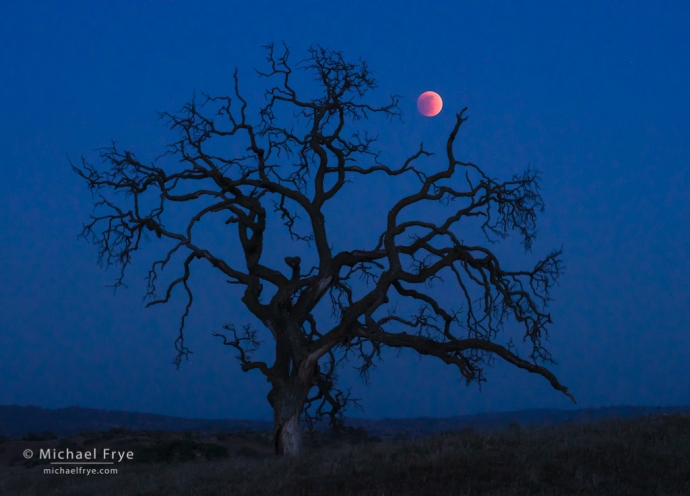On Sunday a total lunar eclipse was visible in many parts of the world, including our corner of California in the Sierra Nevada.
I’ve photographed many lunar eclipses before. I like capturing sequences of the moon above a landscape in various eclipse stages – if possible. But for this eclipse I couldn’t think of any nearby spot that would add a compelling foreground while looking in the right direction (southeast) for a sequence like that, plus it appeared that clouds might interrupt any attempt at capturing a long eclipse sequence.
Instead, I thought of a lone oak tree in the Sierra foothills that might lend itself to a different treatment: a telephoto view of just the tree and eclipsed moon at dusk. I had photographed this tree before, and it looked like the tree and moon would line up well. Using a long lens would make the moon look larger, plus capturing a single frame like this would require only a brief cloud-free interval to work, while a sequence would need several hours of clear skies.
Sunday evening Claudia and I had an early dinner and drove out to my chosen spot. And everything went more-or-less according to plan. The tree and moon did indeed line up well. Clouds were moving in from the north, but the view to the southeast, toward the moon, remained clear for long enough.
The biggest challenge was the wind. We were greeted by a gusty breeze when we reached the lower foothills, and the wind didn’t abate while we were there. Wind can shake the camera and blur images made with telephoto lenses at slow shutter speeds, even with a sturdy tripod. So Claudia held an umbrella to shield the camera from the wind, and I tried to time my exposures for moments of relative calm.
In the end I was able to get many sharp frames, though even in the sharpest images some of the smaller branch tips are blurred, as they moved during the one-second exposures. But that couldn’t be helped, and the trunk and most of the branches were sharp, as was the moon.
And it was nice just getting out and watching the eclipse from this serenely empty and quiet stretch of the Sierra foothills. When the moon first appeared just after sunset it was a partially-eclipsed crescent, but soon the crescent disappeared, and all that was visible was the dim, reddish glow of the fully-eclipsed moon. As the twilight grew dimmer, the moon stood out more. Eventually the moon passed behind some clouds, then re-emerged. Later, sunlight caught the edge of the moon again, and gradually more and more of the moon was illuminated, until it was full again. At that point it looked like just an ordinary full-moon night, with only the memory – and photos – of what the moon looked like earlier.
— Michael Frye
Related Posts: Lunar Eclipse Over the Trona Pinnacles; Lunar Eclipse over Death Valley; Eclipse Journey
Michael Frye is a professional photographer specializing in landscapes and nature. He is the author or principal photographer of The Photographer’s Guide to Yosemite, Yosemite Meditations, Yosemite Meditations for Women, Yosemite Meditations for Adventurers, and Digital Landscape Photography: In the Footsteps of Ansel Adams and the Great Masters. He has also written three eBooks: Light & Land: Landscapes in the Digital Darkroom, Exposure for Outdoor Photography, and Landscapes in Lightroom: The Essential Step-by-Step Guide. Michael has written numerous magazine articles on the art and technique of photography, and his images have been published in over thirty countries around the world. Michael has lived either in or near Yosemite National Park since 1983, currently residing just outside the park in Mariposa, California.










Absolutely exquisite. I especially loved reading about your creative process for this image.
Thanks so much Daniel!
Very, very nice. Hope to see it as a 2022 Top 10 candidate.
Thanks very much Bill!
Love this! It is my favorite “eclipse” photo.
Thank you so much Kathy!
I love this composition – it gave such a serene feeling. It’s nice to see something special … how the sturdy oak was communicating with moon, and not just the big red ball photo (although they can be amazing too).
I agree so much about “just getting out and watching”. I photographed “big ball” and shore compositions – so fun to try, even as high tide and sea mist was a challenge. Loved how the moon changed from pale white crescent w sea mist to twilight reddish wonder.
Thank you for sharing your images and stories.
Thank you Sally! Your description of your seaside attempt sounds beautiful, so I hope you got some images you like.
I forgot to mention..why your composition was so amazing … it appears as though the “two hands and finger” branches are delicately trying to protect or touch or hug the moon. So moving. Thanks again.
Thanks again Sally! I wasn’t thinking about that at the time, but now that you mention it… I did try to find ways get the moon as close to the tree as possible.
Always helpful to read about the choices you make before you hit the shutter. Thanks for the insights.
You’re welcome Chuck – thanks!
Great shot. I had in mind a windmill by us but the clouds were thick so I was not able to get any shots. No moon showed. I am glad to view your image and how you went about getting it.
Thanks Aram, and sorry to hear the moon was blocked by clouds for you.
Micheal, this is just fantastic. The eclipse was covered in clouds here in Simi Valley. I didn’t get to see it.
Thanks for this great frame with the Coast Oak Silhouette. Two of my favorite subjects!
Thanks so much Deborah!